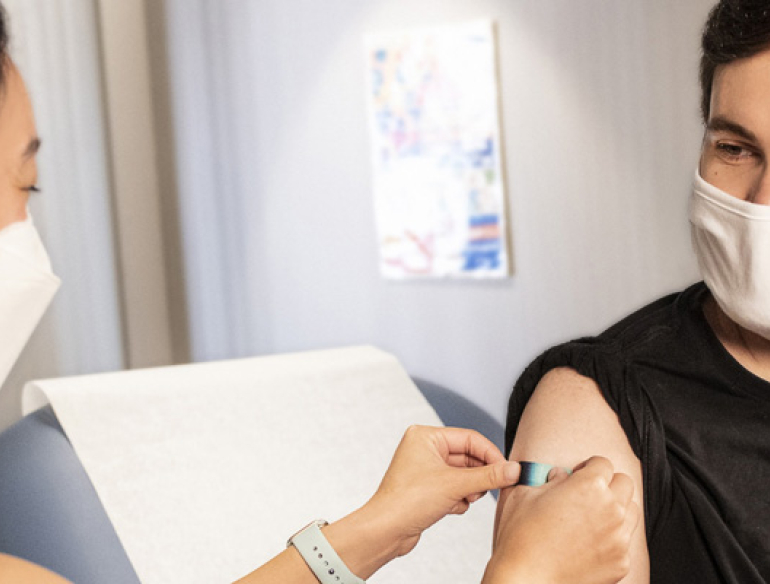A targeted vaccine strategy is critical in preventing infections and reducing deaths if supply does not allow for mass vaccination, a Kirby Institute study shows.
(SYDNEY, Wednesday 5 May 2020) New research from UNSW’s Kirby Institute has used mathematical modelling to determine the effectiveness of a range of vaccination strategies for controlling the COVID-19 pandemic, comparing scenarios of limited vaccine supply against mass vaccination.
The research, published in the journal Vaccine, used the population of NSW as a case study for a hypothetical epidemic scenario starting with 100 cases per day. It provides a roadmap for vaccination goals and possible outcomes of vaccine programs during an epidemic.
The researchers determined that mass vaccination – in this case, vaccinating 66 per cent of the population – with a vaccine efficacy of at least 70 per cent against all infection (both symptomatic and asymptomatic), could achieve herd immunity, and represents the best exit strategy from the pandemic. In NSW, with a population of 7.5 million people, this would mean distributing 60,000-125,000 doses per day, based on the epidemic scenario.
But whilst the Australian vaccine rollout commenced in February 2021, vaccine supply is limited, so there has been a necessary recalibration of our vaccination program, to adopt a more targeted approach.
“A limited supply requires a targeted strategy where particular populations are prioritised,” explains Professor Raina MacIntyre, who led the study. “We show that for a population of 7.5 million people, if faced with an epidemic and an initial restriction in vaccine supply, sustained epidemic control cannot be achieved by this smaller, targeted vaccination strategy. Other non-pharmaceutical interventions, such a face mask use, physical distancing, and limits on the movement of people through travel, will need to continue to mitigate any outbreaks,” she says.
As part of this targeted approach, health worker vaccination is a top priority and is required for health system resilience, and those who are more vulnerable are also prioritised, such as people who are immunocompromised, and the elderly. This approach has the impact of both bolstering essential health system infrastructure and reducing the number of deaths from serious COVID-19 disease, but does not have an impact on epidemic control.
Vaccines as post-exposure prophylaxis
With limited supply, the study examined the concept of using vaccines as a ’post-exposure prophylaxis’, or PEP, meaning people could be vaccinated following exposure to a close contact who tested positive for COVID-19, preventing them from contracting the disease.
“Vaccines are effective as post-exposure prophylaxis for other infections, such as smallpox, hepatitis A, and measles, but we’re yet to test whether COVID-19 vaccines would work in the same way,” says Prof MacIntyre. Researchers in NSW are starting to look at vaccine as post-exposure prophylaxis for SARS-CoV-2, and are hopeful that it will work, as this strategy tends to be successful for viruses with a longer incubation period, which SARS-CoV-2 has. “The study provides a rationale for testing the use of vaccines in close contacts of COVID-19, and if the vaccine proves to be effective when used as PEP, this would be the best use of a limited supply,” says Professor MacIntyre.
The optimal vaccine approach
The ideal approach is mass vaccination, which involves vaccinating an entire population to achieve herd immunity. This approach requires adequate vaccine supply, and has not been undertaken anywhere in the world since the eradication of smallpox.
“Mass vaccination is a huge undertaking, requiring an enormous amount of resources, from workforce and infrastructure to a smooth flow of vaccine supply,” says Professor MacIntyre. The model also demonstrates that rapid vaccination is critical. The efficacy of vaccines, coupled with the capacity to deliver them, impacts on the level of pandemic control and the speed at which herd immunity can potentially be achieved.
“The Pfizer vaccine, which is one of the two vaccines currently available in Australia, has been shown to be 92 per cent effective against all infection, so could potentially achieve herd immunity,” says Professor MacIntyre. “Trial data on the AstraZeneca vaccine shows it does not prevent asymptomatic infection as well, so whether this vaccine can achieve herd immunity is unknown as yet. We do not know yet if boosters will be needed, but high efficacy is the first step toward herd immunity.”
The study shows that ultimately, adequate and effective vaccine supply coupled with rapid delivery is the only way to prevent sustained transmission in the community, and also improve prospects for economic recovery by removing the need for ongoing social restrictions.
“While our model shows that a targeted vaccine strategy can still reduce illness and death from COVID-19 – it is clear that a mass vaccination strategy would be far more effective at controlling disease,” says Professor MacIntyre. “Encouragingly, our model suggest that herd immunity can be achieved in states like NSW by vaccinating two thirds of the population with a high efficacy vaccine.”
Contact
Estelle Jones, Communications Officer, Kirby Institute
Phone
+61 2 9385 9987
